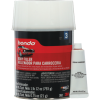It's a great thing. The adhesion and gap filling properties are second to none. I'm convinced that it's even better than epoxy for attaching fiberglass, wood or prepped metal. Epoxies can be too hard and brittle while polyurethane body fillers stay more flexible. I've had spills of both where it got on an area it shouldn't be. The epoxy will chisel off, body filler has to be ground off.
Something I do nearly every time I mix body filler is add polyurethane resin. It makes it spread like creamy butter and aids in even better adhesion. Sometimes I leave it thicker, sometimes super runny.
That purple liquid settled at the top of a new can of Bondo is simply polyurethane resin. And the tube of cream hardener is just a paste form of MEKP.
View attachment 20032
I keep a squeeze bottle with resin ready to go.
View attachment 20033
View attachment 20034















